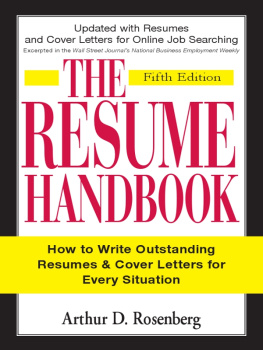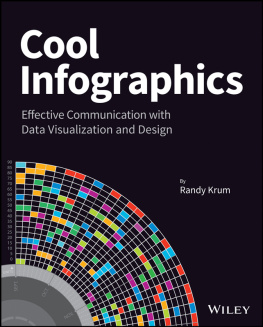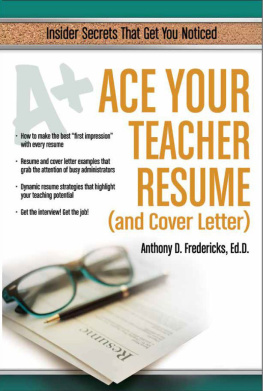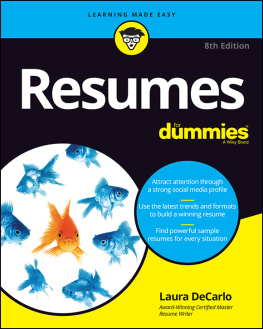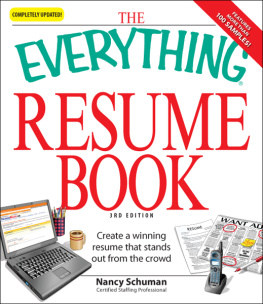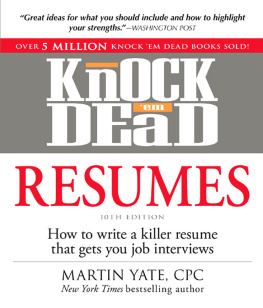Copyright 2014 by Hannah Morgan. All rights reserved. Except as permitted under the United States Copyright Act of 1976, no part of this publication may be reproduced or distributed in any form or by any means, or stored in a database or retrieval system, without the prior written permission of the publisher, with the exception that the program listings may be entered, stored, and executed in a computer system, but they may not be reproduced for publication.
ISBN: 978-0-07-182562-7
MHID: 0-07-182562-2
The material in this eBook also appears in the print version of this title: ISBN: 978-0-07-182557-3, MHID: 0-07-182557-6.
eBook conversion by codeMantra
Version 1.0
All trademarks are trademarks of their respective owners. Rather than put a trademark symbol after every occurrence of a trademarked name, we use names in an editorial fashion only, and to the benefit of the trademark owner, with no intention of infringement of the trademark. Where such designations appear in this book, they have been printed with initial caps.
McGraw-Hill Education books are available at special quantity discounts to use as premiums and sales promotions or for use in corporate training programs. To contact a representative, please visit the Contact Us page at www.mhprofessional.com.
TERMS OF USE
This is a copyrighted work and McGraw-Hill Education and its licensors reserve all rights in and to the work. Use of this work is subject to these terms. Except as permitted under the Copyright Act of 1976 and the right to store and retrieve one copy of the work, you may not decompile, disassemble, reverse engineer, reproduce, modify, create derivative works based upon, transmit, distribute, disseminate, sell, publish or sublicense the work or any part of it without McGraw-Hill Educations prior consent. You may use the work for your own noncommercial and personal use; any other use of the work is strictly prohibited. Your right to use the work may be terminated if you fail to comply with these terms.
THE WORK IS PROVIDED AS IS. McGRAW-HILL EDUCATION AND ITS LICENSORS MAKE NO GUARANTEES OR WARRANTIES AS TO THE ACCURACY, ADEQUACY OR COMPLETENESS OF OR RESULTS TO BE OBTAINED FROM USING THE WORK, INCLUDING ANY INFORMATION THAT CAN BE ACCESSED THROUGH THE WORK VIA HYPERLINK OR OTHERWISE, AND EXPRESSLY DISCLAIM ANY WARRANTY, EXPRESS OR IMPLIED, INCLUDING BUT NOT LIMITED TO IMPLIED WARRANTIES OF MERCHANTABILITY OR FITNESS FOR A PARTICULAR PURPOSE. McGraw-Hill Education and its licensors do not warrant or guarantee that the functions contained in the work will meet your requirements or that its operation will be uninterrupted or error free. Neither McGraw-Hill Education nor its licensors shall be liable to you or anyone else for any inaccuracy, error or omission, regardless of cause, in the work or for any damages resulting therefrom. McGraw-Hill Education has no responsibility for the content of any information accessed through the work. Under no circumstances shall McGraw-Hill Education and/or its licensors be liable for any indirect, incidental, special, punitive, consequential or similar damages that result from the use of or inability to use the work, even if any of them has been advised of the possibility of such damages. This limitation of liability shall apply to any claim or cause whatsoever whether such claim or cause arises in contract, tort or otherwise.
CONTENTS
ACKNOWLEDGMENTS
I am regularly surprised and awed by the amazing opportunities that seem to present themselves and the interconnectedness of people, places, and things in my worldall of which I am incredibly grateful for.
Collaborating with the team at McGraw-Hill Education is a prime example of what a small world we live in! Thank you to Tom Miller, Dannalie Diaz, and Casie Vogel, the talented editors at McGraw-Hill Education. Casies excitement and encouraging words helped fuel the fire to collect and share this information on infographic and other new forms of resumes.
Thank you to the talented graphic designers and dedicated professionals who so willingly allowed me to feature their work in this bookand for the educational conversations that transpired along the way.
My brilliant connections in the recruiting and HR world continue to deliver great insight and filled in the background pieces to help make this book, what I hope will be seen as, a valuable resource. And I owe my humble gratitude to all the career professionals I follow and collaborate with to produce and share amazing work with job seekers.
I am increasingly inspired and curious about the future direction of recruitment and the use of images as well as alternative forms of communication between companies and those seeking employment. I hope, and think, we are on the cutting edge of a long series of advancements in improving the process across both sides of the desk.
Finally, thank you to my family who support me and my friends who endure me! Relationships are the web of life, and mine is incredibly strong because of all of you!
CHAPTER 1
How We Got Where We Are Today
H istorically, job seekers have been required to respond to job postings by submitting a piece of paper (or two) to the organization with the opening. This piece of paper, known as a resume, is supposed to encapsulate the job seekers work experiences, skills, and successes and then convince the reader to call and eventually hire the most qualified job seeker. This is the way it used to go, but today, due to a variety of circumstances, which this chapter will outline, the job seeker has to do more than submit a piece of paper in order to stand out and win the job.
The hiring process as we knew it is broken. Here are 10 ways todays job search has to be different and approached in a new way.
Changes in Hiring, Workforce, and Technology
1. The Death of the Paper Resume
You may have noticed fewer help wanted jobs that request you mail your resume and more employers at career fairs who do not accept hard-copy resumes. The old-fashioned hard-copy paper resume is fading away. It used to be you would type your resume on a typewriter, bring it to a copy shop, and have 100 copies made. Each time you applied for a job, you would type a cover letter, trifold it with the resume and stuff it in a number 10 envelope, seal it and put a stamp on it, travel to the mailbox, and wait.
That was a lot of work, it took time, and the cost of supplies and stamps meant that job seekers were somewhat more discriminatory about the jobs they applied for.
Too Many ApplicantsNot Enough Time
Today, with several mouse clicks, some tweaking of electronic files, and data entry time, a job seeker could conceivably apply for hundreds of jobs in a single day.
So what does this mean for the companies doing the hiring? They are overwhelmed with applications and files with data to search and The summary report found the average job posting received 74 applications. Obviously, some jobs received more and some received less. Imagine reviewing 74 resumes and sifting that down to a manageable number of candidates to phone-screen.
With too many candidates to evaluate in a limited amount of time, recruiters and human resources staff are forced to focus on eliminating candidates rather than learning more about each one. It is estimated that about 50 percent of candidates are not qualified. This number sounds large, but maybe not, given this recent information. TheLadders conducted a study asking people to review job postings. Using sophisticated eye-tracking technology, TheLadders found that 65 percent of the study participants who said they spent up to 10 minutes reading job postings were really only spending, on average, less than a minute per job posting. When the candidate did look at the description, the majority of the time spent was on the title, company name, and then job details (salary and recruiter information).




